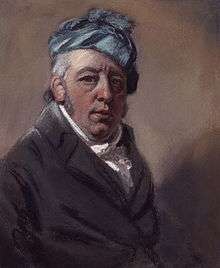John Raphael Smith
| John Raphael Smith | |
|---|---|
|
Sculpture by Sir Francis Chantrey in the V&A | |
| Born |
1751 Derby |
| Died | 2 March 1812 |
| Occupation | painter and mezzotint engraver |
John Raphael Smith (1751 – 2 March 1812) was an English painter and mezzotint engraver, son of Thomas Smith of Derby, the landscape painter, and father of John Rubens Smith, a painter who emigrated to the United States.
Biography
Baptized on 25 May 1751, Smith was apprenticed to a linen-draper in Derby, and afterwards pursued the same business in London, adding to his income by producing miniatures. He then turned to engraving and executed his plate of the Public Ledger, which had great popularity, and was followed by his mezzotints of Edwin the Minstrel (a portrait of Thomas Haden) and Indian Widow,[1] after Wright of Derby, and Mercury Inventing the Lyre, after Barry.

He reproduced some forty works of Reynolds, some of which ranked among the masterpieces of mezzotint, and he was appointed engraver to the Prince of Wales. Adding to his artistic pursuits an extensive connexion as a print-dealer and publisher, he would soon have acquired wealth had it not been for his dissipated habits. He was a boon companion of George Morland, whose figure-pieces he excellently mezzotinted.
Smith was the teacher of J. M. W. Turner. His registered pupils were William Hilton, Charles Howard Hodges, Christiaan Josi, Samuel William Reynolds, James and William Ward (engraver), and Peter de Wint.[2] In 1778 Smith was commissioned to complete a mezzotint engraving by John Milnes following his purchase of a painting and all known engravings of the work of Joseph Wright of Derby. The painting was called The Captive and the engraving was used to make just twenty impressions before it was destroyed. One of these rare engravings is in Smith's home town at the Derby Museum and Art Gallery.[3]
He painted subject-pictures such as the Unsuspecting Maid, Inattention and the Moralist, exhibiting in the Royal Academy from 1779 to 1790. Upon the decline of his business as a printseller he made a tour through the north and midland counties of England, producing much hasty and indifferent work, and settled in Doncaster. The artistic merit of the sculptor Francis Legatt Chantrey was spotted by Smith, who gave him lessons in painting.[4] Chantry later did a bust of Smith in appreciation and there is a painting of Chantry by Smith. Smith died in Doncaster.
As a mezzotint engraver Smith occupies the very highest rank. His prints are delicate, excellent in drawing and finely expressive of colour. His small full-lengths in crayons and his portraits of Fox, Horne Tooke, Sir Francis Burdett and the group of the duke of Devonshire and family support his claims as a successful draughtsman and painter. He had a very thorough knowledge of the principles and history of art, and was a brilliant conversationalist.
Notes
- ↑ The Widow of an Indian Chief Watching the Arms of her Deceased Husband, (Clayton 31), John Raphael Smith, Christies.com
- ↑ John Raphael Smith in the RKD
- ↑ "Pictures". Lowell Libson Ltd. Retrieved 30 June 2011.
- ↑ Burke, Edmund. Annual Register volume 83. p. 232. Retrieved 30 July 2011.
References
 This article incorporates text from a publication now in the public domain: Chisholm, Hugh, ed. (1911). "Smith, John Raphael". Encyclopædia Britannica. 25 (11th ed.). Cambridge University Press. p. 265.
This article incorporates text from a publication now in the public domain: Chisholm, Hugh, ed. (1911). "Smith, John Raphael". Encyclopædia Britannica. 25 (11th ed.). Cambridge University Press. p. 265.
Further reading
| Wikimedia Commons has media related to John Raphael Smith. |
- "An exhibition of engraved works by John Raphael Smith". Manchester [England]: Thomas Agnew & Sons, Spring, 1912. Catalogue raisonne of 99 works.
-
 Graves, Robert Edmund (1898). "Smith, John Raphael". In Lee, Sidney. Dictionary of National Biography. 53. London: Smith, Elder & Co. pp. 87,88.
Graves, Robert Edmund (1898). "Smith, John Raphael". In Lee, Sidney. Dictionary of National Biography. 53. London: Smith, Elder & Co. pp. 87,88.